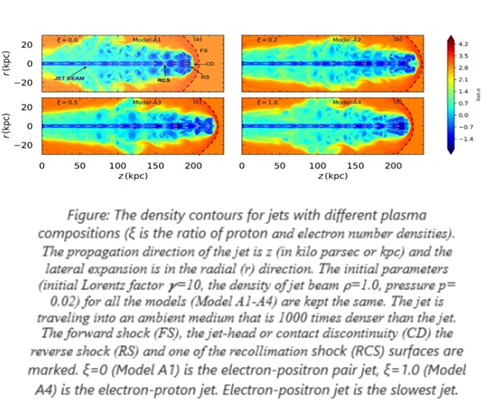Scientists have traced the effect of plasma composition of astrophysical jets which are outflows of ionized matter that are emitted as extended beams from celestial objects like black holes, neutron stars and pulsars.
Despite years of research, it is not known with what kind of matter astrophysical jets are composed of-- whether they are made of bare electrons or protons or whether positively charged electrons called positrons are also present. Knowing the jet composition is vital as it will allow to pinpoint on the exact physical process at work near black holes and neutron stars. In general, in theoretical studies the relation between thermodynamic quantities of the jet like mass density, energy density and pressure do not have the information of composition. Such relation is called equation of state of the jet matter.
Scientists from Aryabhatta Research Institute of observational sciences (ARIES), an autonomous institute of the Department of Science and Technology (DST), Govt. of India, used a relativistic equation of state which was partly proposed by them in an earlier paper on the role of composition of relativistic plasma in the actual evolution of jets.
The research was led by Raj Kishor Joshi and Dr. Indranil Chattopadhyay from ARIES and has been published in the Astrophysical Journal (ApJ). The authors upgraded a numerical simulation code earlier developed by Dr. Chattopadhyay, used the said equation of state to study the dynamics of astrophysical jets composed of mixture of electrons, positrons (positively charged electrons), and protons.

The authors showed that the change in plasma composition leads to the difference in propagation velocities of the jets even if the initial parameters for the jets remain the same. Jets composed of electrons and positrons were found to be slowest in comparison to jets containing protons, contrary to expectation. Protons are about two thousand times more massive than electrons or positrons.
It is essential to understand the plasma composition of jets as the change in plasma composition changes the internal energy of the jet which is reflected in the change in propagation speeds. In addition, the plasma composition also affects the jet structures like number and strength of recollimation shocks, shape and dynamics of reverse shock and so on. Recollimation shocks are the regions in the jet beam that form due to the interaction of the jet beam with the backflowing material.
The electron-positron jets show more pronounced turbulent structures. The growth of these structures also results in the deceleration of the jets. The formation and growth of turbulent structures are known to affect the stability of the jets. Hence, plasma composition may also influence the long-term stability of the jets.
Publication Links: https://iopscience.iop.org/article/10.3847/1538-4357/acc93d/meta
https://arxiv.org/abs/2303.17323
For more details, please contact: Raj Kishor Joshi (raj[at]aries[dot]res[dot]in) and Indranil Chattopadhyay (indra[at]aries[dot]res[dot]in)






























